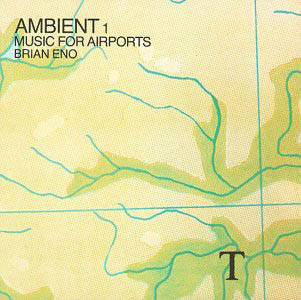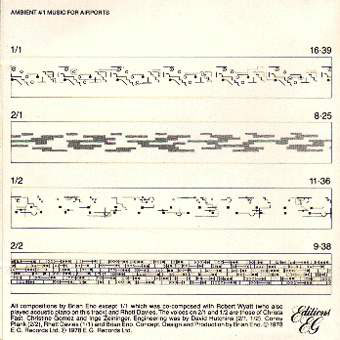Music for Airports, Brian Eno
By Chiu Longina • Mar 2nd, 2008 • Category: AUDIO
http://en.wikipedia.org/wiki/Music_for_Airports
http://es.wikipedia.org/wiki/Brian_Eno
http://en.wikipedia.org/wiki/Brian_Eno
This was the first of four albums released on Eno’s own, then new, Ambient label to actually carry the name “ambient” – a term which he had created to differentiate his minimalistic approach to the album’s material and “the products of the various purveyors of canned music”.
Notice of similarly quiet, unobtrusive music had been given on albums such as Evening Star, Discreet Music, Music for Films and Harold Budd’s The Pavilion of Dreams (which he produced), but in this album it was given precedence as a full-blown concept.
The music was designed to be continuously looped as a sound installation, with the intent to defuse the tense, anxious atmosphere of an airport terminal. It was installed at the Marine Air Terminal of New York’s LaGuardia Airport.
Track listing
The track labelling is the way it is because of the album’s first release (1978) as an LP, and so the first track means “first track, first side”, and so on.
1. “1/1” : Acoustic & electric piano – 16:30
2. “2/1” : Vocals only. – 8:20
3. “1/2” : Vocals; acoustic piano. – 11:30
4. “2/2” : Synthesizer only. – 9:30 (listed on most packaging as 6:00)
All tracks were composed by Eno except “1/1”, which was composed by Eno, former Soft Machine drummer Robert Wyatt, and Rhett Davies.
Music for Airports employs the phasing of tape loops of different length in some tracks, where, for example, in “1/1”, a single piano melody is repeated and at different times other instruments will fade in and out in a complex, evolving pattern due to the phenomenon of phasing: at some point these instrumental sounds will clump together, at some points, be spread apart.
Talking about the first piece, Eno has said:
“… I found this very short section of tape where two pianos, unbeknownst to each other, played melodic lines that interlocked in an interesting way. To make a piece of music out of it, I cut that part out, made a stereo loop on the 24-track, then I discovered I liked it best at half speed, so the instruments sounded very soft, and the whole movement was very slow.”
The two tracks containing the wordless “aaaaah”-style vocals intermingle four tracks which loop back on themselves and constantly interact with each other in new ways. Subtle changes in timing occur, adding to the timbre of the pieces.
Eno explains of the vocal-only piece:
“One of the notes repeats every 23 seconds. It is, in fact, a long loop running around a series of tubular aluminum chairs in Conny Plank’s studio. The next lowest loop repeats every 25 seconds or something like that. The third one every 29 seconds or something. What I mean is they all repeat in cycles that are called incommensurable — they are not likely to come back into sync again. Your experience of the piece, of course, is a moment in time, there. So as the piece progresses, what you hear are the various clusterings and configurations of these six basic elements. The basic elements in that particular piece never change. They stay the same. But the piece does appear to have quite a lot of variety.”
Credits
* Various instruments, cover art & production: Brian Eno
* Vocals : Christa Fast, Christine Gomez, Inge Zeininger
* Acoustic piano : Robert Wyatt
* Engineering : David Hutchins (2/1, 1/2), Conny Plank (2/2), Rhett Davies (1/1) and Eno
* Recording Location:
o Tracks 1-3 : London
o Track 4 : Plank’s Studio, Cologne
LISTEN EXTRACT


Chiu Longina is
Email this author | All posts by Chiu Longina




